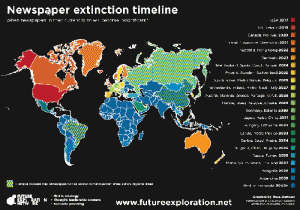
« Keynote on the Future of Global Media in New York | Main | The role of BRIC in the future of global media »
Back in August I predicted that newspapers in their current form will be irrelevant in Australia in 2022. That received significant international attention including from The Australian, The Guardian, Editor & Publisher (which called me the ‘Wizard of Aussie') and many others.
Part of the point I wanted to make was that this date is different for every country. As such I have created a Newspaper Extinction Timeline that maps out the wide diversity in how quickly we can expect newspapers to remain significant around the world. First out is USA in 2017, followed by UK and Iceland in 2019 and Canada and Norway in 2020. In many countries newspapers will survive the year 2040.
The Australian has again covered this in a story title Deadline for newspapers as digital publications rise. There may be some more coverage in coming days.

Phi Beta Iota: Certainly worth reflecting on, this misses two big realities. First, newspapers could still convert themselves into honest citizen intelligence networks and focus on sense-making. Second, five billion poor people are not yet digital and while the dumb cell phone has a bright future, the smart phones and pads do not, in part because of raw earth shortfalls, in part because of embedded toxicity of materials, and in part because even with call centers, there is a very big space that “smart analog” newspapers could fill. The latter is particularly true if one factors in the fact that five billion poor people need alternatives to rote education including primers that can be passed around and do not need power sources.




